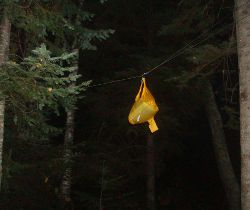Food Protection

 It's not so bad when you're right by the cars on a weekend campout, but if your food is lost while deep in the backcountry on a high adventure, you can be in big trouble. With a couple days hiking between your crew and the nearest trailhead, running out of food probably won't kill you, but it's a big step in that direction.
It's not so bad when you're right by the cars on a weekend campout, but if your food is lost while deep in the backcountry on a high adventure, you can be in big trouble. With a couple days hiking between your crew and the nearest trailhead, running out of food probably won't kill you, but it's a big step in that direction.What? How can a group LOSE their food? - you might ask.
- Water - Rain and crackers don't mix well. Dropping a food bag into a lake or stream can ruin unprotected items. Fortunately, this is easy and light to prevent. Repackage everything into zip-loc bags. This reduces packaging weight and keeps everything safe from moisture. Putting multiple small bags into a larger 2.5 gallon zip-loc increases the protection. It also provides easy garbage storage.
- Dirt - When you drop your ritz cracker with honey on it, you know which side will hit the ground! You can blow dirt off many items, but not all. Being careful when opening packages, passing bowls, and stirring pots is the best protection against dropping and spilling food. No one's going to want those ramen noodles after you tip the cookpot over, are they?
There's not much concern about dirt getting into food while hiking, but spilling food at camp is a common problem. - Stupidity - The food is forgotten in the car, along the trail, or at the previous campsite. By just not paying attention and double-checking yourself, you can forget your food. Yes, I have seen it happen!
- Animals - Critters are opportunists. Anything that smells interesting gets investigated. And, they can find the smallest bits hidden far out of sight so sleeping with your food isn't a great idea. The most common stealers are mice, chipmunks, raccoons, other rodents and birds. Bears generally stay away from people, unless they've been habituated - learned to associate people with easy food. In those popular locations with problem bears, special regulations are in place for visitors which often includes use of bear-proof cannisters.
Whether it's bears or mini-bears (rodents) that are the concern, protecting food is handled in a similar manner. Storing it in a smell-resistant bag and hanging it out of reach keeps it safe.
If bears aren't a concern, as when I hiked the Arizona Trail, there are wire mesh food bags available that mini-bears can't chew through, like OutSak.
For those times when you need to hang, I've found the PCT Method (just google it) to be the best if there are large trees around. Along the Superior Hiking Trail in Minnesota, I could often only find small trees and came up with my own way of hanging so the food is high enough and away from the tree.
- Throw rope with carabiner on end over high branch.
- Clip food bag to carabiner. Lift carabiner and food bag as high up the rope as possible and loop rope through carabiner so it doesn't slide.Walk the other end of the rope away from the tree to move the bag out from the tree.
- Tie rope to another tree as high up as I can reach.
This puts the food bag well over 10 feet up since I can reach up 8 feet. Well, at least I didn't lose any food!
But, here's something new and interesting...
A couple guys at University of Wisconsin in Stout, WI have designed a new product for hanging food bags. It's supposed to be simple to use and secure from pesky food stealers.
They made this video demonstrating how to use it. Unforatunately, there aren't any close-ups of the device or explanation on how it works.
So, take a look and let us all know what you think - innovation or not?
Scout On
Posted: 14:54 02-26-2013 954
Comments:
Feb 28, 2013 - Bob Taylor
Thanks for posting this. If you go to their website, www.advancedwildernesssolutions.com/, there is a better look at the device. They have also come up with other uses for it. They also have a facebook page.
Comment or Question about this page:
Scouting 2025 - Ask a Question - Add Content
Just for Fun: Socializing merit badge




This site is not officially associated with Scouting America
Find more Scouting Resources at www.BoyScoutTrail.com



Follow Me, Scouts
Recent Comments